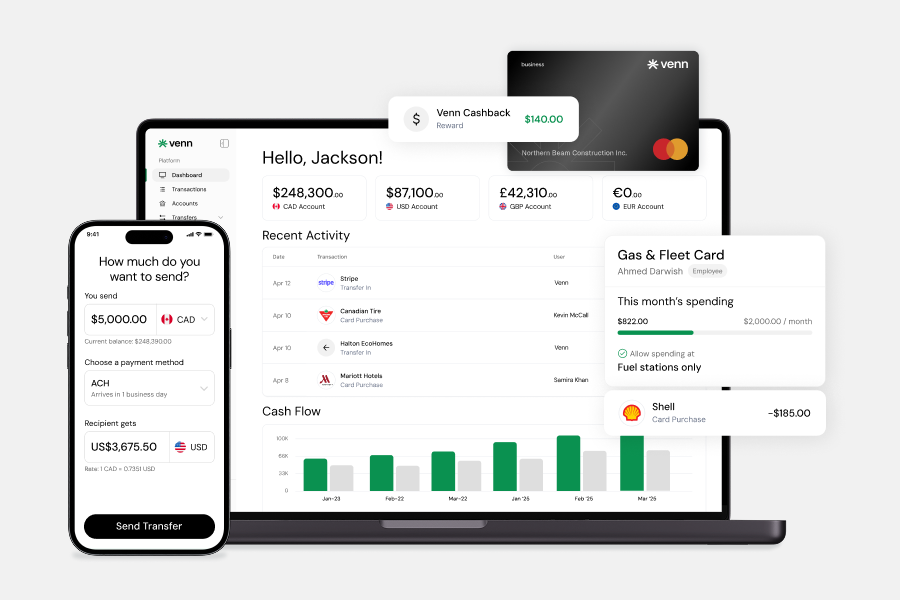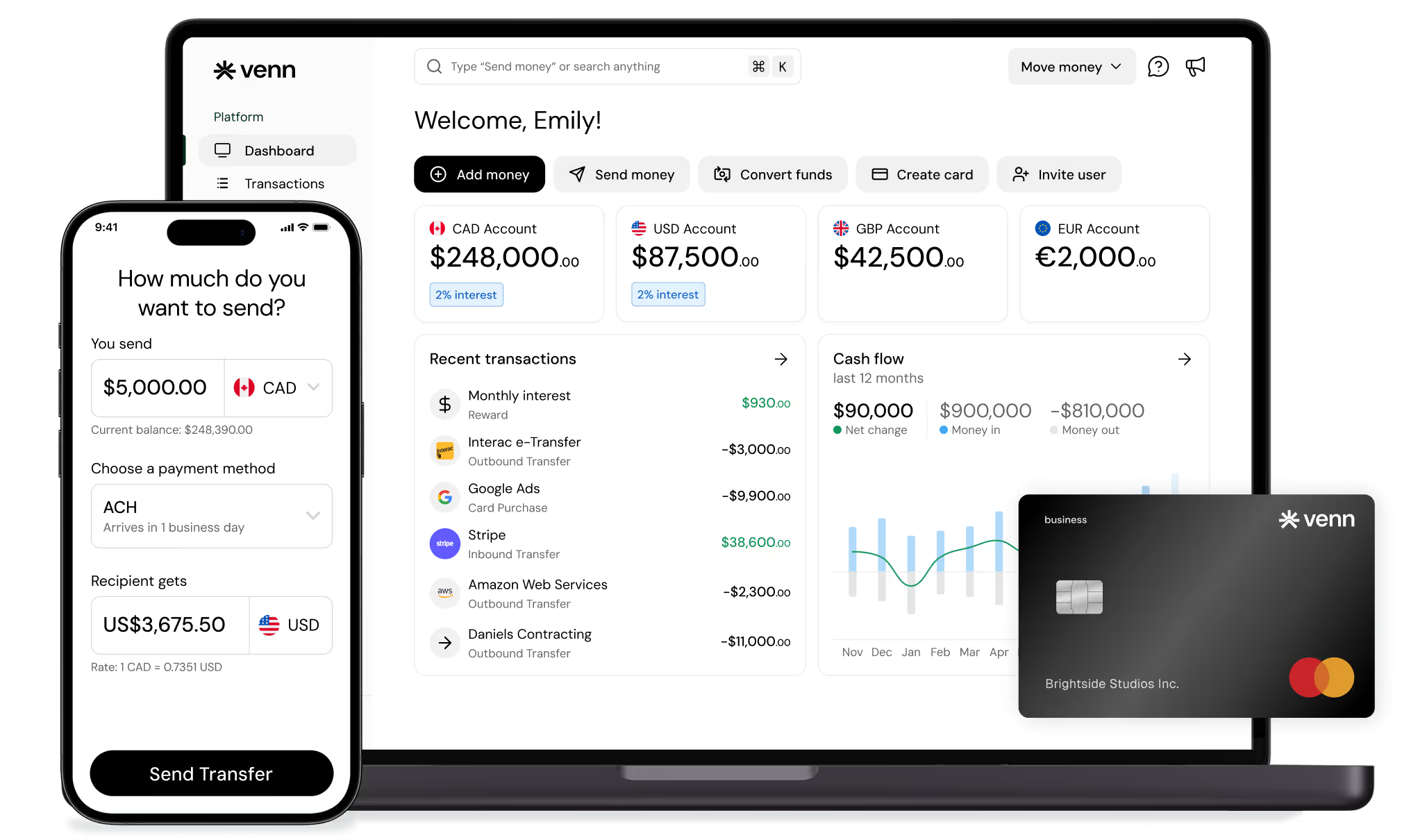What Net Payment Terms Mean for Canadian Businesses
Confused by Net 15, Net 30, or Net 60 payment terms? Learn what net payment terms mean, how they impact your cash flow, and when to offer them as a Canadian business owner.


Trusted by 5,000+ Canadian businesses
Business banking for Canada
Local CAD and USD accounts, corporate cards with cashback, the lowest FX rates in Canada, free local transfers, and more.
What Are Net Payment Terms?
If you’ve ever received or issued an invoice with “Net 15” or “Net 30” in the corner, you’ve seen a net payment term in action.
What does “Net 30” mean?
A net payment term defines how many days a customer has to pay after an invoice is issued. For example:
- Net 15: Payment is due 15 days from the invoice date
- Net 30: Payment is due in 30 days
- Net 60: Payment is due in 60 days
These are calendar days, not business days, unless stated otherwise.
So if you send an invoice dated October 1st with Net 30 terms, the client is expected to pay by October 31st.
Why are net terms used?
Net terms are a standard way to offer short-term credit to clients. You’re effectively giving customers extra time to pay without charging interest, a common practice in B2B transactions across industries like construction, manufacturing, and professional services.
It’s a balancing act:
- Clients get breathing room to manage their own cash flow
- You (the business) take on the risk of delayed payment
Are net terms required?
No. Net terms are entirely optional. Some businesses require prepayment, others use milestone billing or due on receipt. But net terms have become the norm in many industries, and understanding them can help you negotiate smarter and plan your cash flow with more precision.
How Do Net Terms Work in Canada?
While “Net 30” or “Net 60” means the same thing globally, payment is due within a set number of days, how you apply those terms in Canada affects everything from tax reporting to vendor relationships.
When Do Net Terms Start?
Net terms typically begin on the invoice issue date, not the delivery date or end of the month, unless specifically stated (e.g., “Net 30 EOM” = payment due 30 days after month-end).
Here’s how it usually works:
- Invoice issued: October 1
- Terms: Net 30
- Payment due: October 31
If you use accounting software like QuickBooks or Xero, Venn can sync these due dates automatically and trigger reminders, helping prevent overdue payments without manual follow-up.
Tax Timing in Canada (GST/HST Implications)
In Canada, when you issue an invoice, even if it won’t be paid for 30 or 60 days, you’re still on the hook to remit GST/HST for that period. This is critical.
That means:
- You may owe sales tax to the CRA before you’ve collected the money
- Delayed payment from clients can create a cash flow crunch if you're not careful
Tip: Many Canadian small businesses use Net 15 or Net 30 to keep receivables tight and avoid paying GST/HST out-of-pocket.
🧾 Payment Methods Also Matter
- Cheque: Still common with legacy vendors, but delays are inevitable
- EFT or Interac e‑Transfer®: Faster, more reliable, and increasingly preferred
- Global clients: May pay via wire or ACH, which affects when funds actually clear
With Venn, you can offer clients multiple payment methods, including local Interac e‑Transfer® or ACH via your US account, and get notified as soon as the money lands.
Net 15 vs. Net 30 vs. Net 60: Key Differences
Each net payment term affects your cash flow, client relationships, and accounting cycles differently. Choosing the right one, or understanding what you’ve been offered, depends on how flexible your business can afford to be and can have a real impact on your businesses finances.
Which Term Should You Use?
- Startups and SMBs often prefer Net 15 or Net 30, since cash flow is more sensitive and every delay matters.
- Enterprise clients may insist on Net 60, even if it strains your business.
- Early-stage businesses with limited reserves should avoid Net 60 unless payment guarantees are in place.
If you're managing multiple payment terms across vendors and clients, using a tool like Venn helps you automate due dates, reconcile receivables, and flag overdue payments without manually checking spreadsheets. Delayed payments can hurt your working capital, with 46% of B2B payments being past due in 2024.
Pro Tip: Some vendors offer early payment discounts with longer terms, like “2/10 Net 30” (2% off if paid in 10 days). These can be win-win if managed well but are often not recommended due to the complexity of the payments.
When and Why to Offer Net Terms as a Business
Offering net payment terms, like Net 15, Net 30, or Net 60, can be a powerful lever for growing your business, but it comes with trade-offs.
Benefits of Offering Net Terms
- Increases deal win rates
Many B2B buyers expect net terms as a default. Extending flexibility can help close more deals, especially with larger clients or government buyers. - Strengthens customer loyalty
Clients who are given payment flexibility often prefer to stay with vendors who respect their cash flow cycle. - Aligns with industry norms
In sectors like wholesale, agency services, and SaaS, offering Net 30 or Net 60 may be necessary just to compete.
Risks of Net Terms
- Delayed cash inflows
You’re doing the work or shipping the product before seeing the money. That can create a crunch, especially if you need to pay your own vendors sooner. - Increased collections workload
More terms mean more follow-ups, reconciliations, and the risk of aging receivables, unless you have automation in place. - GST/HST timing pressure
In Canada, you still owe sales tax based on your invoice date, even if payment comes 30 or 60 days later.
Use Net Terms Strategically
Instead of offering net terms by default:
- Start with Net 15 or Net 30 for trusted clients
- Offer Net 60 only when the ROI justifies the delay
- Consider early payment incentives (e.g., 2/10 Net 30) to encourage faster turnaround
Tools like Venn help you automate invoice syncing, track due dates, and get paid faster, without chasing down payments manually.
How to Decide Which Net Term to Offer (or Request)
Choosing the right payment term isn’t one-size-fits-all. It depends on how you operate, who you serve, and how much working capital you can afford to wait on.
Ask Yourself These 5 Questions:
- What’s my cash flow runway?
If you rely on fast receivables to pay suppliers or run payroll, Net 15 might be your ceiling. If you’ve got reserves or flexible payment terms yourself, Net 30 or Net 60 may be manageable. - Who is the client?
- Startups or solopreneurs may need shorter terms to avoid delays
- Enterprise or government buyers often require Net 60 or longer, but can typically be trusted to pay
- Is this a one-time project or ongoing relationship?
For recurring work, offering leniency can build trust. For first-time engagements, tighter terms reduce exposure. - What are my own vendor terms?
If your suppliers give you Net 30, but you’re offering Net 60 to clients, you may run into a mismatch that hurts cash flow. - Do I have the systems to track and enforce terms?
Without automated invoicing and payment tracking, longer net terms can easily become overdue invoices and awkward follow-ups.
Decision Flow (Simplified)
- Tight cash flow? → Start with Net 15
- Need to compete on flexibility? → Consider Net 30
- Dealing with large buyers? → Be prepared for Net 60, but back it with automation
Alternatives to Net Terms (and When to Use Them)
Net terms aren’t the only way to structure payment. Depending on your business model, client profile, or risk appetite, other approaches may make more sense — especially if you're trying to protect cash flow or reduce administrative overhead.
When Should You Avoid Net Terms?
- Low-margin or short-turnaround businesses where cash needs to move fast
- High-risk clients with no payment history or weak credit
- When you're scaling rapidly and don’t have the resources to chase late payments
Use Net Terms Selectively
You don’t have to choose one model forever. Many Canadian SMBs use a blended approach:
- Net 30 for repeat clients
- Upfront deposits for custom work
- Subscription billing for ongoing service retainers
Tips to Get Paid Faster (Even with Net Terms)
Offering Net 15 or Net 30 doesn’t mean you’re stuck waiting or chasing payments forever. With the right tactics, you can speed up collections without straining client relationships.
Proven Strategies for Faster Payment
1. Set clear terms upfront
- Use simple language (e.g., “Payment due 30 days after invoice date”)
- Include the due date on the invoice, not just the terms
2. Invoice promptly and consistently
- Send the invoice as soon as the work is complete
- Use invoicing software that integrates with your accounting system
3. Automate reminders
- Send polite nudges a few days before and after the due date
- Tools like Venn sync with QuickBooks and Xero to trigger reminders automatically
4. Offer early payment incentives
- Example: “2/10 Net 30” (2% discount if paid within 10 days)
- Use only if your margins support the discount
5. Accept multiple payment methods
- E-transfers, bank debits, credit cards, even Stripe or PayPal
- Remove friction by letting the client choose how they pay
6. Build terms into your contracts
- Include late payment penalties or interest
- Make net terms enforceable — not just hopeful
Tools That Can Help
- Venn: Automates invoice syncing and reminders, supports multi-method payments, and tracks receivables in real-time
- QuickBooks: Accounting platform with strong invoicing and reporting workflows
- PandaDoc: Build contract terms into signed agreements for clarity and enforceability
FAQs for Net Payment Terms
Q: What does “Net 30” mean in payment terms?
“Net 30” is a credit term that means the client must pay the full invoice amount within 30 calendar days from the invoice date (or another agreed-upon date, such as the delivery date). If an invoice is issued on October 1, the payment is due by October 31. It essentially acts as a short-term, interest-free loan you extend to the buyer.
Q: What’s the difference between Net 15, Net 30, and Net 60?
The difference is the time allowed for the buyer to remit payment, all measured in calendar days from the agreed start date:
- Net 15: Payment is due in 15 days.
- Net 30: Payment is due in 30 days (the most common term).
- Net 60: Payment is due in 60 days (often used for large enterprises or long-standing relationships).The longer the net term, the greater the cash flow burden on your business.
Q: Can I offer Net 30 and still get paid faster?
Yes. You can incentivize faster payments by combining the Net 30 term with an early payment discount (e.g., “2/10 Net 30” means a 2% discount if paid within 10 days). Additionally, using automated tools to send invoices immediately and follow up with payment reminders significantly reduces the average time it takes for payment to arrive.
Q: Is Net 30 legally binding?
Only if the terms are clearly documented and agreed to in writing by both parties. You must include the payment terms, due date, and any late payment fees in your signed contract, service agreement, or estimate to make them enforceable in court. Simply printing "Net 30" on an invoice is not sufficient on its own.
The comparative information provided on this page is based on publicly available sources and is accurate to the best of our knowledge as of October 12th, 2025. Features, pricing, and terms may change without notice. For the latest information, please consult each provider’s official website directly. All trademarks and product names are the property of their respective owners. Their use does not imply any affiliation with or endorsement by those brands.
Venn is all-in-one business banking built for Canada
From free local CAD/USD accounts and team cards to the cheapest FX and global payments—Venn gives Canadian businesses everything they need to move money smarter. Join 5,000+ businesses today.

Frequently asked questions
Everything you need to know about the product and billing.
Venn is the cheapest and easiest way to manage your business banking needs. We offer the best currency exchange rates in Canada, chequing accounts in multiple currencies, domestic and international bank transfers, and a corporate Mastercard to manage all your spend. By signing up to Venn you automatically get:
- Accounts in Canadian dollars, US dollars, British pounds, and Euros
- The cheapest FX rates in Canada with free domestic transfers (EFT, ACH, SEPA, FPS)
- A Mastercard Corporate card that gets you the same great FX rates and cashback with no minimum spend requirements
Yes, Venn holds eligible deposits at our Partner Institution in our trust accounts, including deposits in foreign currencies. CDIC protects eligible deposits up to CA$100,000 per deposit category per CDIC member institution.
No, we don’t have any hidden fees! All charges, including currency conversion and premium plans, are clear and transparent. You can even issue unlimited corporate cards to your team and sign up with a free plan in minutes! Learn more about our transparent Pricing.
Nope! Other companies and traditional bank accounts have high minimum balance requirements. This makes accounts inaccessible for small businesses or individuals. Venn does not require a minimum balance. Your CAD and USD funds will also earn 2% interest regardless of the balance.
Our process is quick — Customers typically get set up in 5 minutes or less! Create a free account and start saving with no monthly fees, cashback on card spend, and the best FX rates around.
Of course! Our friendly Support specialists are available via Chat or Email 24 hours a day, 7 days a week, 365 days a year. All tickets are monitored and responded to within 24 hours, with an average response time of 30 minutes.
Yes, we have a direct integration with QBO and Xero. We are working on more integrations very soon!
Join 5,000+ businesses banking with Venn today
Streamline your business banking and save on your spend and transfers today
No personal credit check or guarantee.


